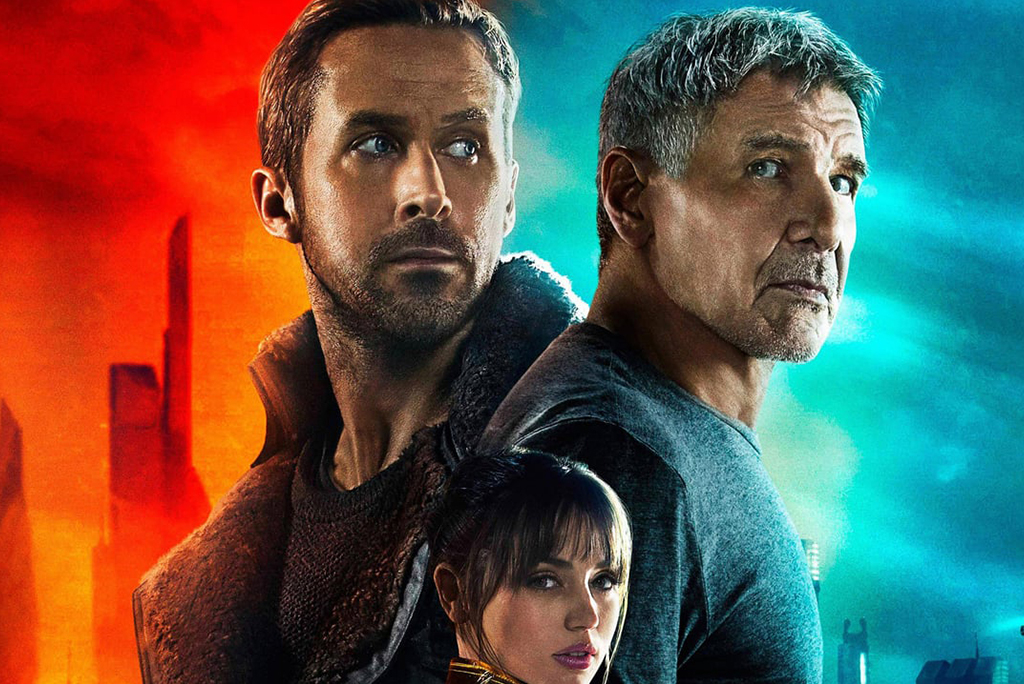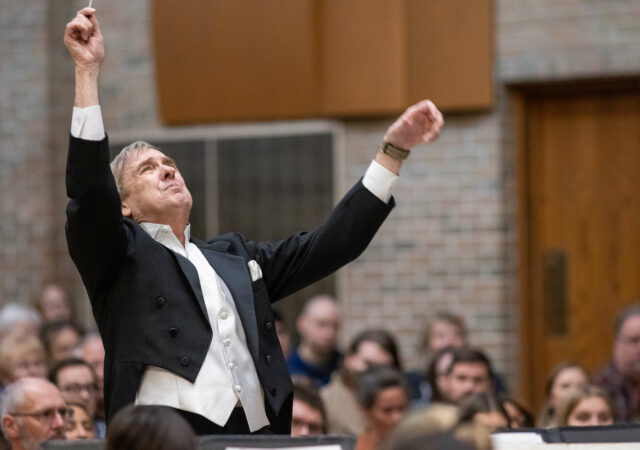(Rated: 13+/14A [Canada: check local listings] and R [MPAA] for violence, some sexuality, nudity and language; directed by Denis Villeneuve; stars Ryan Gosling, Harrison Ford, Dave Bautista, Robin Wright, Ana de Armas, Sylvia Hoeks, Edward James Olmos, Jared Leto, Mackenzie Davis, Hiam Abbass and Sean Young; run time: 163 min.)
Souls searching for a miracle
By Ted Giese
(For those who have not yet seen the film, please be advised that this review includes spoilers to better discuss the theological elements of the narrative.)
With “Blade Runner 2049” (2017), Canadian director Denis Villeneuve provides an admirable sequel to Ridley Scott’s sci-fi masterpiece “Blade Runner” (1982).
Set 30 years after the first film, the dystopian future Villeneuve presents is grimmer and bleaker than Scott’s. Advances in technology, collapses in the natural world and questions of what it means to be human intensify as the development of artificial intelligence and replicant bioengineered androids brings the slogan “More human than human” closer to reality.
In the first film, “replicants” — derogatorily referred to as “skinjobs” — were prohibited on earth. Pioneered by the Tyrell Corporation, they were meant to be used as “slave labor” in off-world colonies. If discovered on earth, they would be “retired” by a mercenary parapolice bounty hunter called a Blade Runner, who needed to be a sort of film noir detective to pick them out of the crowd. Blade Runners worked hard to avoid “retiring” a human by mistake.
In “Blade Runner 2049,” the authorities have lifted the prohibition against replicants, and newer models, now produced by the Wallace Corporation (which bought out the Tyrell Corporation), have been engineered to obey their human masters. Because rogue older models still exist, mixed in with both humans and the new compliant replicant population, Blade Runners remain a necessary evil.
One replicant, KD6.3–7 (Ryan Gosling), who goes by “K” (an abbreviation of his serial number), is also a Blade Runner tasked with hunting down his own kind. The film follows his investigation into a group of renegade replicants harboring a dangerous secret. His search leads him into a mystery, raising unexplored questions about himself and his origins. Eventually his path crosses with former Blade Runner Rick Deckard (Harrison Ford), hiding out in desolate, radioactive Las Vegas.
WARNING: Major spoilers ahead
Early in the film, K has a showdown with a renegade replicant, Sapper Morton (Dave Bautista), a protein farmer who says to K that the only reason K can do his job is “because [he’s] never seen a miracle.” The miracle in question is a replicant giving birth to a baby.
What K uncovers is that replicants went to great lengths to hide both the birth and the child. K’s superior officer, Lt. Joshi (Robin Wright), highlights the danger of this secret’s becoming known, telling K, “The world is built on a wall that separates kind. Tell either side there’s no wall. … You’ve bought a war.”
She tasks him with killing the child before anyone understands what has happened, to which K replies, “I’ve never retired anything that was born before. … To be born means to have a soul.”
Along the way Joshi assures K that he’s “gotten by okay without a soul” and that he doesn’t really need one for his work — that he’s simply tasked to obey and erase all evidence of this miracle birth.
Why doesn’t K simply do what he’s told? Does he have a soul?
As with the first film and Philip K. Dick’s 1968 novella Do Androids Dream of Electric Sheep? (on which “Blade Runner” was based), “Blade Runner 2049” asks trans-humanist questions.
Trans-humanism is a philosophical movement that contemplates the barrier between humanity and technology, asking such questions as: Can humanity transmigrate from the biological to the synthetic? Can memories, dreams, the spirit and/or the soul be transmigrated into a machine or a biological clone to extend life and “hack” mortality? Can human consciousness evade death by artificial means? Can an artificial intelligence attain consciousness? There are scientists around the world currently engaged in studying these questions.
Can anyone but God create life?
Christians should be aware of this field of inquiry, especially as it runs up against the first article of the Apostles’ Creed. When Christians confess that they “believe that God has made [them] and all creatures; that He has given [them their] body and soul, eyes, ears, and all [their] members, [their] reason and all [their] senses, and still takes care of them,” what does it mean if humanity can “seemingly” do these things without God? Does humanity then break the First Commandment, “You shall have no other gods,” and claim the title of God “Almighty, maker of heaven and earth,” for itself in an act of defiance?
In the film, the character Niander Wallace (Jared Leto) seems to think so.
As head of the Wallace Corporation, Wallace fancies himself a god, even describing the replicants he’s made as angels. He takes a page from the book of Hebrews, seeing his replicants as ones who are fashioned and “sent out to serve” (Heb. 1:14) and describing rebellious past models as “fallen angels.”
Since Wallace is limited by time and resources, he, too, is interested in acquiring the miraculous child to reverse-engineer it and advance his own replicants as replacements for humanity, which he considers doomed to die out in the near future. Again, he would in this way supplant God and, as he says, “storm the gates of Eden.”
Wallace is one of those villains who is both at odds with God and yet the only character regularly quoting Scripture or making biblical allusions.
The miracle child both Wallace and K are looking for is the product of a sexual union between the Blade Runner Deckard and the Tyrell Corporation replicant Rachel (Sean Young). By the end of “Blade Runner” (1982), Deckard and Rachel have fallen in love and escaped to live together in secret. The new information provided by “Blade Runner 2049” is that Tyrell was on the cusp of an innovation with Rachel who, it turns out, was a prototype designed to conceive and bear a child.
As “Blade Runner” (1982) concludes, however, Eldon Tyrell (founder of the Tyrell Corporation) unexpectedly dies, murdered by one of his own “creations.” In “Blade Runner 2049,” to reproduce Tyrell’s research, Wallace sends Luv (Sylvia Hoeks), his relentless personal replicant, to bring together Rachel’s remains (she died in childbirth) and Deckard, the child’s father.
While holding Rachel’s skull, Wallace speaks to Deckard, borrowing from Genesis: “God remembered Rachel in her barrenness … and opened her womb” (Gen. 30:22–23), a reference to the biblical Rachel who miraculously bore Jacob’s son Joseph even though she’d been barren her whole life.
Deckard and Rachel’s child, now an adult, is either potentially the messiah of the renegade replicants who want freedom from slavery (a sort of Moses/Christ character), or, from a human perspective, an anti-Christ (a harbinger of the end of biological humanity). Wallace sees the child as a way to cement his god status, with his angel children spreading out into the universe.
As a side note, the “Director’s Cut” (1992) and “Final Cut” (2007) of the original “Blade Runner” featured a number of memory/dream images of a unicorn in a forest. This imagery and Gaff’s (Edward James Olmos) origami paper unicorn have, until now, been associated with Deckard and the question of whether he is a replicant. “Blade Runner 2049” is rather vague on this question; however, with the new information provided in Villeneuve’s film, this imagery from the first film could be re-interpreted as prophetically referring to Deckard and Rachel’s child, introduced in this new film in a forest environment.
While not a Scripturally-tenable allusion, the unicorn image grew historically within Christianity to be connected to Jesus Christ and His incarnation, especially in the Middle Ages and Renaissance. The unicorn’s horn was believed to hold medicinal properties capable of purifying water and/or healing the sick.
It’s interesting, then, that much of “Blade Runner 2049” focuses on tracking down the miracle progeny of Deckard and Rachel, especially since it couches their child in messianic terms. The last dialogue in “Blade Runner” (1982) comes as Deckard holds up the origami unicorn, and, referring to Rachel, remembers Gaff’s words: “It’s too bad she won’t live … but then again, who does.”
With the addition of this new film, perhaps Gaff’s words become prophetic; maybe the one who does “live” is Deckard and Rachel’s child — the unicorn everyone is seeking, who may hold in her DNA healing for a sick world.
A “worthy successor” to the original
While “Blade Runner” (1982) borrowed stylistically from the Fritz Lang German silent film “Metropolis” (1927), for modern sci-fi it was a kind of watershed film, dividing the genre into “before ‘Blade Runner’” and “after ‘Blade Runner.’” Numerous films have attempted to emulate or pay homage to Scott’s original. Villeneuve has masterfully expanded on what Scott accomplished, providing viewers an expansion on the original story and a deepening of its mystery.
Those who over the years disliked “Blade Runner” (1982) because of its dark overtones, bleak subject matter and slow pacing will find their disdain extending to the new film. Villeneuve keeps a slow, atmospheric approach with sparse dialogue and non-verbal acting.
Dick’s novella asked, Do Androids Dream of Electric Sheep? “Blade Runner 2049” adds more questions: Can androids lie or love? Can they have a soul?
Scripture says God, not man, makes souls (Eccl. 12:7). As trans-humanism advances, what response will Christians give if developers claim that synthetic, mass-produced androids have souls? How will Christians react if science fiction appears to become science reality?
“Blade Runner” and “Blade Runner 2049” pose thought-provoking questions for Christians and non-Christians alike.
As a film, “Blade Runner 2049” is a worthy successor to its precursor. This is no “revitalization” or updated frenetic PG-13 action extravaganza assembled to lure the teenaged crowd. The film demonstrates that Villeneuve is a genuine fan of the original while at the same time showing his considerable talent as a filmmaker.
That said, while “Blade Runner 2049” doesn’t fully match the original, it should receive high marks for what it accomplishes. It’s risky to tackle a sequel to an initially unpopular film that originally hit theatres 35 years ago and is now considered a masterpiece. Villeneuve made a film that does not disappoint, and that makes it a success.
The fact that it speaks to the darkness awaiting humanity if we continue down our current path is also commendable. It’s interesting to ponder the idea that technology could produce profound loneliness and existential dread in a world teeming with people, and that this same loneliness and angst might be passed on to created technology by its makers. This thought fits the cynical axiom “misery loves company.”
Christians will want to reflect on the true source of life and immortality: the miracle virgin birth of Christ Jesus and His resurrection from the dead; the promises of personal resurrection in Him, and a true miracle — the coming reordering of the material and spiritual world on the Last Day.
“Blade Runner 2049” is set in a world that has lost track of this hope, yet it’s a world filled with the need for Christ. The silver lining is that it is also a world looking for a miracle even though supposedly miracles no longer happen.
The Rev. Ted Giese (pastorted@sasktel.net) is lead pastor of Mount Olive Lutheran Church, Regina, Saskatchewan, Canada; a contributor to the Canadian Lutheran, Reporter Online and KFUO.org; and movie reviewer for the “Issues, Etc.” radio program. Follow Pastor Giese on Twitter @RevTedGiese
Posted Oct. 25, 2017






Well done review. I saw the movie yesterday, and your review filled in a few questions for me, and matched what I thought of the movie. Very thought provoking movie and this could be our dystopian future we are looking at. And it is disturbing to think about from an environmental perspective and who we are as a species.